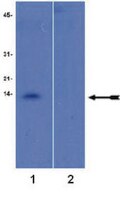Free and chromatin-associated mono-, di-, and trimethylation of histone H4-lysine 20 during development and cell cycle progression.
Karachentsev, Dmitry, et al.
Dev. Biol., 304: 46-52 (2007)
2007
Pokaż streszczenie
Methylation of specific amino acids in histone tails is responsible for packaging DNA into condensed, repressed chromatin, and into open chromatin that is accessible to the transcription machinery. Monomethylation and trimethylation of histone H4-lysine 20 (H4-K20) control the formation of repressed chromatin. Using antibodies that specifically recognize the three methyl marks of histone H4-K20, we characterized their regulation during the cell cycle and throughout development. We find free mono- and trimethylated histone H4-K20 in unfertilized Drosophila eggs and in S2 tissue culture cells. Soluble mono-. di-, and trimethylated H4-K20 are also found in HeLa cells. These soluble modified histones may represent a pool of free histones that can rapidly be incorporated into chromatin. The three methyl marks are each regulated differentially during development and their detection on western blots does not overlap with their detection on chromosomes. Monomethylated H4-K20 is detected on condensed chromosomes throughout development, while di- and trimethylated H4-K20 are detected on metaphase chromosomes at specific stages. Our results suggest that the detection of methylated H4-K20 on chromosomes may reveal chromatin packaging rather than the distribution of the methyl marks. | 17229421
 |
Histone trimethylation and the maintenance of transcriptional ON and OFF states by trxG and PcG proteins.
Papp, B; Müller, J
Genes & development
20
2041-54
2005
Pokaż streszczenie
Polycomb group (PcG) and trithorax group (trxG) proteins act as antagonistic regulators to maintain transcriptional OFF and ON states of HOX and other target genes. To study the molecular basis of PcG/trxG control, we analyzed the chromatin of the HOX gene Ultrabithorax (Ubx) in Ubx(OFF)and Ubx(ON)cells purified from developing Drosophila. We find that PcG protein complexes PhoRC, PRC1, and PRC2 and the Trx protein are all constitutively bound to Polycomb response elements (PREs) in the OFF and ON state. In contrast, the trxG protein Ash1 is only bound in the ON state; not at PREs but downstream of the transcription start site. In the OFF state, we find extensive trimethylation at H3-K27, H3-K9, and H4-K20 across the entire Ubx gene; i.e., throughout the upstream control, promoter, and coding region. In the ON state, the upstream control region is also trimethylated at H3-K27, H3-K9, and H4-K20, but all three modifications are absent in the promoter and 5' coding region. Our analyses of mutants that lack the PcG histone methyltransferase (HMTase) E(z) or the trxG HMTase Ash1 provide strong evidence that differential histone lysine trimethylation at the promoter and in the coding region confers transcriptional ON and OFF states of Ubx. In particular, our results suggest that PRE-tethered PcG protein complexes act over long distances to generate Pc-repressed chromatin that is trimethylated at H3-K27, H3-K9, and H4-K20, but that the trxG HMTase Ash1 selectively prevents this trimethylation in the promoter and coding region in the ON state. | 16882982
 |














